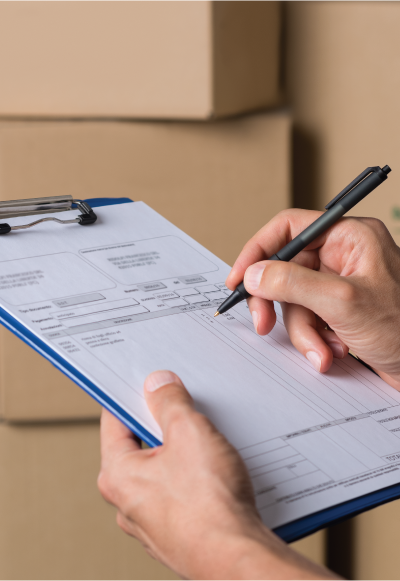Table of Contents
** Minutes
What is GST (goods and services tax)?
How to handle GST as an ecommerce business
How ShipBob delivers GST compliance peace of mind to ecommerce businesses
As your prepare to expand your ecommerce business internationally, there’s a lot to look forward to. But amid the excitement of growing your business, there’s also a lot that you have to prepare for – and that includes tax compliance.
While US-based brands might be used to U.S. sales taxes, there are several other countries that require the GST, or “Goods and Services Tax.” To ensure an efficient international expansion for your brand, and a seamless purchasing and delivery experience for your customers all around the world, you’ll need to know the ins and outs of GST.
In this post, we’ll dive deep into what GST is, why it’s important, and how to handle GST for your ecommerce business.
What is GST (goods and services tax)?
GST, or Goods and Services Tax, is a type of consumption tax levied in some countries on products that are sold domestically and to buyers in other countries. While many brands opt to build GST in the cost of the product as a sales tax which the customer then pays for, ecommerce sellers are ultimately responsible for rendering the payment to the government.
GST compliance is crucial when you sell to any one of the following countries:
- Canada
- Australia
- New Zealand
- Singapore
- India
- Maldives
- Papua New Guinea
Types of goods and services taxes
Most countries use a single GST system, which applies a standard rate to all goods and services supplied across their respective countries. However, in countries like India, there are several types of GST that may be applied depending on the where and how the sale is conducted.
CGST
CGST, or Central Goods and Services Tax, is GST collected by the central government. It is applied when the purchase and sale of goods take place within the same state, otherwise known as “intra-state” transactions.
CGST is almost always accompanied by SGST.
SGST
SGST, or State Goods and Services Tax, is GST collected by the state government. This state tax is applied along with the CGST for intra-state transactions, so that both the country’s overarching government and the state governments get a portion of the tax revenue.
Example: A Mumbai-based ecommerce brand sells goods to a customer in Mumbai. A CGST of 6% and an SGST of 6% apply to the goods in question. Subsequently, the seller charges a total of 12% GST and deposits the revenue to the central government and the Maharashtra state government.
IGST
IGST, or Integrated Goods and Services Tax, is a simpler tax that is levied on inter-state transactions (when the purchase and supply of goods take place between different states).
IGST also applies to goods and services imported into the country, which means that IGST will be collected when a buyer based in that country purchases goods from a different country.
The tax revenue from IGST is shared between the central and state governments. Although IGST also applies to exports, they’re considered as zero-rated supplies and thus essentially cost the seller nothing.
Example: An ecommerce seller based in Mumbai imports goods from a brand based in the United States. In this example, we’ll say that for this particular type of goods, an IGST of 12% applies. The U.S. brand collects the GST from the seller and then deposits the revenue with the Indian central government.
Importance of GST for ecommerce businesses
GST isn’t something ecommerce businesses can ignore; rather, it can have big implications for your business. Here are just some of the ways that GST impacts brands selling internationally.

GST compliance
Failing to collect GST, deposit the revenue, or file your GST return will result in expensive penalties and fines. In addition to the massive financial blowback, your business could also face legal issues (such as fraud charges) in the case of severe GST non-compliance.
A thorough understanding of GST law will help you maintain GST compliance. This prevents accidental tax evasion and ensures that you’re filing your tax returns accurately and on time. That way, you can fulfill your legal obligations when shipping globally, helping you avoid expensive penalties and legal repercussions.
If you have a fulfillment partner like ShipBob handling your international fulfillment and shipping, make sure that they integrate with leading tax automation tools (such as Avalara, Taxtually, and TaxJar).This allows you to automatically collect taxes and file your GST returns.

Impact on pricing and profitability
GST can affect your product pricing, which in turn can affect your business’s bottom line and profits.
When brands calculate and add GST at checkout, customers might be surprised at the extra charge and abandon their carts after realizing that they’ll have to pay more than they anticipated. Many brands choose to build GST into the product’s listed price to avoid this surprise, but this can make your products come across as more “expensive” than they actually are and deter budget-conscious shoppers in the first place.
While neither option is ideal, there are ways to navigate implementing GST to mitigate its impact on the customer journey. You’ll need to evaluate your brand’s demand levels, sales patterns, and financials to create a pricing strategy that works for you.

Documentation and tax calculations
The GST registration and filing processes require that you maintain a number of essential documents, including trade licenses and clearance certificates. As a result, ecommerce brands selling internationally will need to be up-to-speed on all required documentation and track transactions closely for tax purposes down the road.
The process of calculating GST tax can be extremely complicated – especially for businesses dealing with a large number of international sales. Having a diverse variety of goods can also complicate the calculation process, especially if those goods fall under different GST slabs. Additional costs like import duties and shipping only further complicate the process.
Tax and e-invoicing tools can help you maintain all your GST documents and multichannel transactions in one place. Some even come with smart product classifications for accurate and real-time tax calculations.
How to handle GST as an ecommerce business
As an ecommerce business, there are four action items for GST: registration, collection, payment, and filing.
GST registration process
The process of registering for GST depends on the country that you’re selling to. Each country has a different GST registration process, along with a unique set of requirements. Most countries will require some proof of identity as well as documents proving that your business is legitimate and legal. Each country will also have a dedicated website where you can complete your GST registration online.
Here are some of the requirements listed on the official government sources of each country.
| Country | Requirements | How to Register |
| Australia | Australian Business Number (ABN) Proof of identity Business structure Details of business activities and associates | Register for GST through the Business Registration Service. |
| Canada | Business number (BN) Effective date of registration Fiscal year for GST/HST Total annual revenue Basic business information | Register for GST through Business Registration Online. |
| India | Tax identification number Proof of business incorporation Address proof Bank account proof Digital signature | Register for GST through the GST portal. |
| Maldives | Completed Maldives Inland Revenue Authority (MIRA) 105 form Company registration number Basic information | Register for GST through MIRA. |
| New Zealand | IRD number Business industry classification (BIC) code Bank account number for GST refunds Business turnover in the last 12 months Expected business turnover in the next 12 months | Register for GST through Inland Revenue. |
| Papua New Guinea | Taxpayer Identification Number (TIN) Completed GST registration form | Registration forms are available at any IRC (Internal Revenue Commission) GST website. |
| Singapore | Copy of latest profit and loss account Copy of rental agreement For overseas businesses, Letter of Authorization to appoint a local agent to comply with their GST legal obligations | Register for GST through the myTax Portal. |
GST filing and payment
Once you have a GST registration, you’ll be provided a unique GST number, or “GSTN.” This number will be used as a reference when making payments and filing your annual returns.
Most countries will give you the option to pay GST through their respective taxation portals. You can also use the same portals for your annual return filing. In most cases, however, you’ll have to enter the tax liability yourself. This can be tricky since it also means you need to perform the tax calculation yourself, which can be complex if you’re handling large quantities of eligible transactions each year.
The best workaround for this is to have an automated tax calculation system that’s integrated with your ecommerce platforms. This will automatically identify all the applicable purchases for which you need to collect GST, calculate the due amount in real-time, and include the charge before the customer makes the payment.
That way, the GST you’ve collected will be automatically recorded and maintained in one centralized system. This will simplify the process of calculating, paying, and filing GST further down the line.
GST rates and categories
One of the most complex aspects of ecommerce GST compliance is calculating tax rates. This is especially challenging if you’re selling to multiple countries that use GST since each country has a different tax system in place. That means there will be a separate tax structure, product categorization system, concessions, and exemptions list for each country.
Australia
In Australia, the goods and services tax for most goods is 10%, with some exceptions and zero-rated supplies. Most overseas businesses selling to Australian customers are liable to collect GST. This includes businesses selling services, digital goods, and goods worth AUD 1,000 or less.
Canada
There’s a standard 5% federal GST rate that applies across Canada. Additionally, the Provincial Sales Tax (PST) is levied by each province at a rate ranging between 6% and 10%. Certain items, such as basic groceries and prescription medication, as well as some transportation and medical devices, are considered zero-rated supplies.
India
India has one of the most comprehensive GST categorization systems, with tax rates that fall under four slabs – 5%, 12%, 18%, and 28%. Most items fall under the 18% tax slab, including entertainment tax for tickets to events, movies, and shows. Luxury commodities and and consumer durables fall under the highest tax slab of 28%. Essential commodities (like eggs, milk, and curd) and education services fall under zero-rated supplies.
Maldives
With the exception of certain supplies, most goods and services in the Maldives are taxed at a standard GST rate of 8%.
New Zealand
In New Zealand, the standard tax rate of 15% GST applies to most goods and services. A reduced rate of 9% applies to services like long-term hotel accommodations. Real estate, financial services, and precious metals are exempt.
Papua New Guinea
There’s a standard 10% GST that applies to most goods and services sold in Papua New Guinea. However, certain categories that fall under educational, medical, or financial services are exempt.
Singapore
In Singapore, most goods and services are taxed at a standard rate of 9%. However, there are exemptions on transactions that involve residential properties, financial services, currency exchanges, bank operation charges, loans, and life insurance policies.
How ShipBob delivers GST compliance peace of mind to ecommerce businesses
Navigating the complexities of GST is part and parcel of your international fulfillment strategy – and as a leading fulfillment platform, ShipBob is here to help optimize your cross-border logistics.
ShipBob’s global infrastructure, expertise, and best practices enable brands to scale their ecommerce operations worldwide with ease. While ShipBob is not a tax partner and does not advise brands on their tax obligations, we’re here to optimize your fulfillment strategy no matter where you sell or ship.
Global fulfillment network
ShipBob’s global network of fulfillment centers helps you sell seamlessly to international customers. You can store your inventory strategically across different ShipBob locations in the US, the UK, Europe, Canada, and Australia to speed up fulfillment and reduce shipping costs for customers in different countries (including those that apply GST).
“We’ve been utilizing ShipBob’s fulfillment centers in the US, Australia, and Canada, and the UK. We also recently launched in Europe using ShipBob.
Shipping cross-border is never easy, especially when you’re shipping a product that qualifies as a dangerous good since our products contain alcohol. By storing inventory in ShipBob’s facilities within the countries or near the geographies we’re shipping to, we can bypass a lot of the complexities of international shipping. It makes our lives significantly easier. But more importantly, shipping locally instead of internationally is better for customers.
You can always navigate cross-border complexities, but you can’t undo a customer’s stressful delivery experience. Leveraging ShipBob’s global network to fulfill and ship locally reassures our customers, so that when someone in a key market like Australia or Canada buys from us, they’re not worrying about their order getting stuck in customs or wondering if they’ll ever get their items. They also know it’s not going to take two weeks or more to be delivered, and they don’t have to pay exorbitant international shipping rates.”
Sergio Tache, Founder and CEO of Dossier
Inventory placement program (IPP)
ShipBob’s Inventory Placement Program (IPP) lets you automate your inventory distribution process to meet demand as quickly and cost-effectively as possible. The program’s proprietary algorithm automatically identifies the most optimal inventory split across ShipBob’s dozens of fulfillment centers worldwide, so that you can improve shipping times while lowering shipping costs. This helps you bolster your bottom line, and preserve profits despite extra taxes, duties, or customs fees you incur.
“We’re using ShipBob’s Inventory Placement Program to manage inventory allocation and distribution, and it’s been super helpful for us. We send our inventory to one hub location, and from there, ShipBob determines the most strategic split of inventory across its fulfillment center network and distributes our inventory for us.
Having the ability to reduce shipping costs through distributed inventory is probably the difference between profitability and unprofitability for most businesses in the DTC space – so the fact that ShipBob’s network enables brands to do it so easily is a huge differentiator.”
Neil Blewitt, SVP of Operations at Bloom Nutrition
Technology integration
ShipBob’s robust partner ecosystem includes leading tax platforms to simplify tax calculation, payments, and return filing processes. Integrations with platforms like TaxJar allow for real-time tax calculations using smart product classifications based on accurate HTS codes. You can even automate filing by automatically submitting your returns and remittances to the respective states where you have a registration.
Customs and duties management
If your brand sells to customers in the US, UK, Netherlands, Canada, or Australia, you can leverage ShipBob’s international fulfillment centers to fulfill orders within the country you’re shipping to, eliminating customs and duties on DTC orders.
If your shipments require customs clearance, ShipBob’s delivery duty paid or DDP shipping solution enables you to calculate and present customers with all the necessary duties and taxes at checkout, so they aren’t left on the hook for those costs later on. This transparency can be a huge conversion lever for international sellers, and can help your brand lower your cart abandonment rate and boost customer loyalty.
“We also leverage ShipBob Delivered Duties Paid (DDP) shipping to reach our customers outside of the US. Using ShipBob DDP allows us to ship worldwide and we’re lucky that ShipBob has a solution like that because we’ve used it since we onboarded. ShipBob has great worldwide support. We’re really looking forward to activating other countries with ShipBob, especially because we don’t have someone internally with global expansion expertise. It will be helpful to work with ShipBob to make sure those launches go smoothly. ”
Kayleigh Christina, Co-Founder and CMO of CLEARSTEM
For more information on how ShipBob can help you optimize your international fulfillment, click the button below to get in touch.
Goods and Services Tax (GST) FAQs
Below are answers to the most commonly asked questions about GST.
Who is supposed to pay GST – the retailer or the customer?
The customer pays the GST to a retailer, while the retailer remits it to the government.
How does GST impact ecommerce businesses?
GST compliance is a critical aspect of fulfilling and shipping ecommerce orders internationally, and failure to adhere to GST regulations can lead to legal trouble for your business. GST will also increase the cost to customers to purchase your products, which may impact your product pricing strategy and your brand’s profitability.
How can ShipBob help with GST compliance?
While ShipBob is not a tax partner and does not advise brands on their tax obligations, our global fulfillment network enables brands to either fulfill orders in the country they are shipping to (to avoid cross-border complexities, duties, and customs altogether) and our integrations with leading tax platforms to help automate GST calculation and compliance.

































